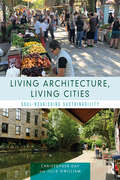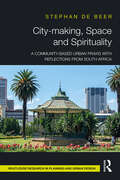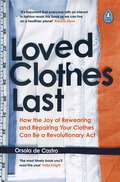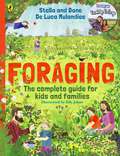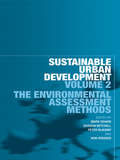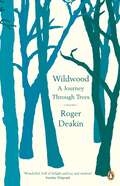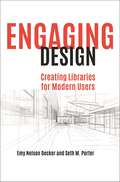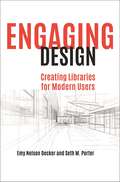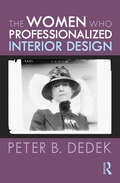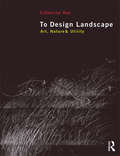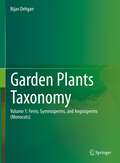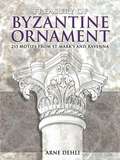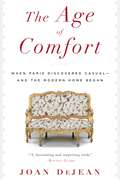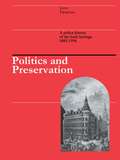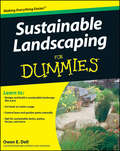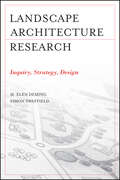- Table View
- List View
Living Architecture, Living Cities: Soul-Nourishing Sustainability
by Christopher Day Julie GwilliamIt’s widely accepted that our environment is in crisis. Less widely recognized is that three quarters of environmental damage is due to cities – the places where most of us live. As this powerful new book elucidates, global sustainability is therefore directly dependent on urban design. In Living Architecture, Living Cities Christopher Day and Julie Gwilliam move beyond the current emphasis on technological change. They argue that eco-technology allows us to continue broadly as before and only defers the impending disaster. In reality, most negative environmental impacts are due to how we live and the things we buy. Such personal choices often result from dissatisfaction with our surroundings. As perceived environment has a direct effect on attitudes and motivations, improving this can achieve more sustainable lifestyles more effectively than drastic building change – with its notorious performance-gap limitations. As it’s in places that our inner feelings and material reality interact, perceived environment is place-based. Ultimately, however, as the root cause of unsustainability is attitude, real change requires moving from the current focus on buildings and technology to an emphasis on the non-material. Featuring over 400 high quality illustrations, this is essential reading for anyone who believes in the value and power of good design. Christopher Day’s philosophy will continue to inspire students with an interest in sustainable architecture, urban planning and related fields.
City-making, Space and Spirituality: A Community-Based Urban Praxis with Reflections from South Africa
by Stéphan de BeerThis book is about the soul of the city, embodied in its spaces and people. It traces dynamics in inner city neighbourhoods of South Africa’s post-apartheid capital, Pretoria. Viewing the city through its most vulnerable people and places, it recognizes that urban space is never neutral and shaped by competing value frameworks. The first part of the book invites planners, city-makers, and ordinary urban citizens, to consider a new self-understanding, reclaiming their agency in the city-making process. Through the metaphor of "becoming like children", planning practice is deconstructed and re-imagined. A praxis-based methodology is presented, cultivating four distinct moments of entering, reading, imagining and co-constructing the city. After deconstructing urban spaces and discourses, the second part of the book explores a concrete spirituality and ethic of urban space. It argues for a shift from planning as technocracy, to planning as immersed, participatory artistry: opening up to the "genius" of space, responsive to urban cries, and joining to construct new, soul-full spaces. Local communities and interconnected movements become embodiments of urban alternatives – through resistance and reconstruction; building on local assets; animating local reclamations; and weaving nets of hope that will span the entire city. Providing a concrete methodology for city-making that is rooted in a community-based urban praxis, this book will be of interest to urban planning researchers, professional planners and designers and also grass-root community developers or activists.
City-making, Space and Spirituality: A Community-Based Urban Praxis with Reflections from South Africa
by Stéphan de BeerThis book is about the soul of the city, embodied in its spaces and people. It traces dynamics in inner city neighbourhoods of South Africa’s post-apartheid capital, Pretoria. Viewing the city through its most vulnerable people and places, it recognizes that urban space is never neutral and shaped by competing value frameworks. The first part of the book invites planners, city-makers, and ordinary urban citizens, to consider a new self-understanding, reclaiming their agency in the city-making process. Through the metaphor of "becoming like children", planning practice is deconstructed and re-imagined. A praxis-based methodology is presented, cultivating four distinct moments of entering, reading, imagining and co-constructing the city. After deconstructing urban spaces and discourses, the second part of the book explores a concrete spirituality and ethic of urban space. It argues for a shift from planning as technocracy, to planning as immersed, participatory artistry: opening up to the "genius" of space, responsive to urban cries, and joining to construct new, soul-full spaces. Local communities and interconnected movements become embodiments of urban alternatives – through resistance and reconstruction; building on local assets; animating local reclamations; and weaving nets of hope that will span the entire city. Providing a concrete methodology for city-making that is rooted in a community-based urban praxis, this book will be of interest to urban planning researchers, professional planners and designers and also grass-root community developers or activists.
Loved Clothes Last: How the Joy of Rewearing and Repairing Your Clothes Can Be a Revolutionary Act
by Orsola de Castro'It's important that everyone with an interest in fashion reads this book so we can live on a healthier planet' Arizona Muse 'The most timely book you'll read this year' India Knight* * * * * Running out of space for the clothes you can't stop buying? Curious about how you can make a difference to the environmental challenges our planet faces? Join Orsola's care revolution and learn to make the clothes you love, last longer.This book will equip you with a myriad of ways to mend, rewear and breathe new life into your wardrobe to achieve a more sustainable lifestyle. By teaching you to scrutinise your shopping habits and make sustainable purchases, she will inspire you to buy better, care more and reduce your carbon footprint by simply making your loved clothes last longer.Following Orsola's practical tips to lavish care and attention on the clothes you already own will not only have a positive environmental impact, but will be personally rewarding too: hand wash, steam and spot clean your clothes, air dry instead of tumble drying, or revive your clothes by sewing or crocheting.Fast fashion leaves behind a trail of human and environmental exploitation. Our wardrobes don't have to be the finish line; they can be a starting point. We can all care, repair and rewear. Do you accept the challenge?* * * * *'An incredibly thoughtful, must-read guide' Kenya Hunt'A must read for anyone who wants to understand the fashion industry as an outsider and wants direction as to where we go next' Aja Barber
Foraging: The fun and easy guide to the great outdoors
by Stella and De Luca MulandieeFrom the writers behind the extraordinary Knowledge to Forage comes an incredible guide to the great outdoors . . .Welcome to the world of foraging.Have you ever been on a long (and probably boring) walk through woods or fields, or even the streets around where you live?If you have, then all around you are undiscovered secrets. A whole world of nature and plants and flowers just waiting to be found.In this amazing book, we'll tell you all about how you can become an expert in foraging - which is a way to find incredible food, medicines and even soaps in the natural world around you.After reading this book, you'll be able to:- Find the best berries and plants for making yummy foods- Learn about the incredible stories hidden in the flowers and plants and trees you see every day (and some you might never have spotted).- Impress your friends with your incredible knowledge of the natural world - and help them protect it!With handy tips and colourful illustrations, Family Foraging is a comprehensive guide to nature and foraging, which will allow children to explore the great outdoors with friends and families.*Includes a full and comprehensive safety guide*
Sustainable Urban Development Volume 2: The Environmental Assessment Methods (Sustainable Urban Development Series)
by Mark Deakin Gordon Mitchell Peter Nijkamp Ron VreekerIn this book, the second of a three-volume series, leading authorities on the methodology of environmental assessment provide a unique insight into questions of critical importance to sustainable urban development. Using the framework and protocols set out in Volume 1, Volume 2 examines how well the environmental assessment methods evaluate the ecological integrity of urban development and equity of the resulting resource distribution. The examination focuses on: the instruments of environmental assessment approaches to environmental assessment based in systems-thinking methods for environmental, economic and social assessments their use in evaluating the sustainability of urban development. The Sustainable Urban Development Series contains the research and debate of the BEQUEST (Building, Environmental Quality Evaluation for Sustainability) network funded by the European Commission. Together the books provide a framework, set of protocols, environmental assessment methods and toolkit for policy makers, academics, professionals and advanced level students in urban planning and studies, as well as other areas of the built environment.
Sustainable Urban Development Volume 2: The Environmental Assessment Methods (Sustainable Urban Development Series #Vol. 2)
by Mark Deakin Gordon Mitchell Peter Nijkamp Ron VreekerIn this book, the second of a three-volume series, leading authorities on the methodology of environmental assessment provide a unique insight into questions of critical importance to sustainable urban development. Using the framework and protocols set out in Volume 1, Volume 2 examines how well the environmental assessment methods evaluate the ecological integrity of urban development and equity of the resulting resource distribution. The examination focuses on: the instruments of environmental assessment approaches to environmental assessment based in systems-thinking methods for environmental, economic and social assessments their use in evaluating the sustainability of urban development. The Sustainable Urban Development Series contains the research and debate of the BEQUEST (Building, Environmental Quality Evaluation for Sustainability) network funded by the European Commission. Together the books provide a framework, set of protocols, environmental assessment methods and toolkit for policy makers, academics, professionals and advanced level students in urban planning and studies, as well as other areas of the built environment.
Wildwood: A Journey Through Trees
by Roger DeakinRoger Deakin's Wildwood is a much loved classic of nature writingWildwood is about the element wood, as it exists in nature, in our souls, in our culture and our lives.From the walnut tree at his Suffolk home, Roger Deakin embarks upon a quest that takes him through Britain, across Europe, to Central Asia and Australia, in search of what lies behind man's profound and enduring connection with wood and with trees.Meeting woodlanders of all kinds, he lives in shacks and cabins, travels in search of the wild apple groves of Kazakhstan, goes coppicing in Suffolk, swims beneath the walnut trees of the Haut-Languedoc, and hunts bush plums with Aboriginal women in the outback.Perfect for fans of Robert Macfarlane and Colin Tudge, Roger Deakin's unmatched exploration of our relationship with trees is autobiography, history, traveller's tale and incisive work in natural history. It will take you into the heart of the woods, where we go 'to grow, learn and change''Enthralling' Will Self, New Statesman'Extraordinary . . . some of the finest naturalist writing for many years' Independent'Masterful, fascinating, excellent' Guardian'An excellent read - lyrical and literate and full of social and historical insights of all kinds' Colin Tudge, Financial Times'Enchanting, very funny, every page carries a fascinating nugget. Should serve to make us appreciate more keenly all that we have here on earth . . . one of the greatest of all nature writers' Craig Brown, Mail on Sunday'Breathtaking, vividly written . . . reading Wildwood is an elegiac experience' Sunday TimesRoger Deakin, who died in August 2006, shortly after completing the manuscript for Wildwood, was a writer, broadcaster and film-maker with a particular interest in nature and the environment. He lived for many years in Suffolk, where he swam regularly in his moat, in the river Waveney and in the sea, in between travelling widely through the landscapes he writes about in Wildwood. He is the author of Waterlog, Wildwood and Notes from Walnut Tree Farm.
Engaging Design: Creating Libraries for Modern Users
by Emy Nelson Decker Seth M. PorterThis book demonstrates how aesthetics, design elements, and visual literacy can be implemented in the library to enhance spaces, programs, services, instruction, and outreach so that your library will appeal to all users.Libraries have come to accept that they must rethink how they appeal to users, and harnessing the power of design can be a powerful means for addressing the changing needs of the community. Decker and Porter introduce "engaging design"—an umbrella term that incorporates multiple design frameworks with a focus on a three-prong approach: aesthetics, design thinking, and service design. These frameworks can be used to guide design choices that will aid in teaching and engaging current and potential library users.In the course of a lively and interesting narrative, Engaging Design introduces basic concepts of aesthetics and good design and explores examples of its successful uses in the academic, public, and special library. It provides simple steps for implementing subtle, but powerful, techniques to improve instruction, human-computer interaction, e-learning, public services spaces, wayfinding signage, and all manner of library programs, events, and services. In addition, the authors recommend easy-to-implement best practices that will help librarians to enhance library-goers' experience. Library administrators will also look to this book for assistance in best addressing the needs of the modern library user.
Engaging Design: Creating Libraries for Modern Users
by Emy Nelson Decker Seth M. PorterThis book demonstrates how aesthetics, design elements, and visual literacy can be implemented in the library to enhance spaces, programs, services, instruction, and outreach so that your library will appeal to all users.Libraries have come to accept that they must rethink how they appeal to users, and harnessing the power of design can be a powerful means for addressing the changing needs of the community. Decker and Porter introduce "engaging design"—an umbrella term that incorporates multiple design frameworks with a focus on a three-prong approach: aesthetics, design thinking, and service design. These frameworks can be used to guide design choices that will aid in teaching and engaging current and potential library users.In the course of a lively and interesting narrative, Engaging Design introduces basic concepts of aesthetics and good design and explores examples of its successful uses in the academic, public, and special library. It provides simple steps for implementing subtle, but powerful, techniques to improve instruction, human-computer interaction, e-learning, public services spaces, wayfinding signage, and all manner of library programs, events, and services. In addition, the authors recommend easy-to-implement best practices that will help librarians to enhance library-goers' experience. Library administrators will also look to this book for assistance in best addressing the needs of the modern library user.
The Women Who Professionalized Interior Design
by Peter DedekThe Women Who Professionalized Interior Design explores the history of interior decorating and design from the late nineteenth century to the present, highlighting the careers and contributions of significant American female interior designers who were instrumental in the creation of the field of residential and commercial interior design in the United States. This book explores how interior design emerged as a distinct, paying occupation in the nineteenth century thanks to a growing middle class and an increase in available cheap household goods following the Industrial Revolution. Focusing primarily on the period from 1905 to 1960, it addresses the complex relationships among professionals in the design fields, the social dynamics of designer-client relationships, and how class, culture, and family influenced their lives and careers. The book emphasizes significant female interior decorators and writers on design including Candace Wheeler, Elsie de Wolfe, Edith Wharton, Nancy McClelland, Ruby Ross Wood, Dorothy Draper, Eleanor McMillen Brown, and Sister Parish, all of whom are underrepresented in the historical record, relating their stories within the context of the history of design and architecture. This book is an ideal and concise resource for students and faculty of interior design and women’s history.
The Women Who Professionalized Interior Design
by Peter DedekThe Women Who Professionalized Interior Design explores the history of interior decorating and design from the late nineteenth century to the present, highlighting the careers and contributions of significant American female interior designers who were instrumental in the creation of the field of residential and commercial interior design in the United States. This book explores how interior design emerged as a distinct, paying occupation in the nineteenth century thanks to a growing middle class and an increase in available cheap household goods following the Industrial Revolution. Focusing primarily on the period from 1905 to 1960, it addresses the complex relationships among professionals in the design fields, the social dynamics of designer-client relationships, and how class, culture, and family influenced their lives and careers. The book emphasizes significant female interior decorators and writers on design including Candace Wheeler, Elsie de Wolfe, Edith Wharton, Nancy McClelland, Ruby Ross Wood, Dorothy Draper, Eleanor McMillen Brown, and Sister Parish, all of whom are underrepresented in the historical record, relating their stories within the context of the history of design and architecture. This book is an ideal and concise resource for students and faculty of interior design and women’s history.
To Design Landscape: Art, Nature & Utility
by Catherine DeeTo Design Landscape sets out a distinctively practical philosophy of design, in accessible format. Based on the notion that landscape design is a form-based craft addressing environmental processes and utility, Dee establishes a framework for approaching such craft with modesty and ingenuity, using the concept of "aesthetics of thrift".Employing numerous case studies-as diverse as Hellerup Rose Garden in Denmark; Bloedel Reserve, Bainbridge Island, USA; Rousham Gardens, Oxfordshire, UK and Tofuku-ji, in Kyoto, Japan - to illustrate her ideas, the book is a beautiful portfolio of Dee's drawings, which are both evocative and to the point.The book begins with a 'Foundations' section, which sets out the basis of the approach. ?'Principles' chapters then elaborate eleven significant considerations applicable to any design project, regardless of context and scale. Following on, 'Strategies' chapters reinforce the principles, and suggest further ways of designing, adaptable to different conditions. Dee ends with a focus on 'Elements', case studies and verb lists providing sources for the designer to consider how the components - vegetation, water, terrain, structures, soils, weather, and the sky - ?might be engaged, mediated and joined.Catherine Dee’s book is for all those who would craft landscape, from the gardener, to the professional landscape architect, to the student of design
To Design Landscape: Art, Nature & Utility
by Catherine DeeTo Design Landscape sets out a distinctively practical philosophy of design, in accessible format. Based on the notion that landscape design is a form-based craft addressing environmental processes and utility, Dee establishes a framework for approaching such craft with modesty and ingenuity, using the concept of "aesthetics of thrift".Employing numerous case studies-as diverse as Hellerup Rose Garden in Denmark; Bloedel Reserve, Bainbridge Island, USA; Rousham Gardens, Oxfordshire, UK and Tofuku-ji, in Kyoto, Japan - to illustrate her ideas, the book is a beautiful portfolio of Dee's drawings, which are both evocative and to the point.The book begins with a 'Foundations' section, which sets out the basis of the approach. ?'Principles' chapters then elaborate eleven significant considerations applicable to any design project, regardless of context and scale. Following on, 'Strategies' chapters reinforce the principles, and suggest further ways of designing, adaptable to different conditions. Dee ends with a focus on 'Elements', case studies and verb lists providing sources for the designer to consider how the components - vegetation, water, terrain, structures, soils, weather, and the sky - ?might be engaged, mediated and joined.Catherine Dee’s book is for all those who would craft landscape, from the gardener, to the professional landscape architect, to the student of design
Home: The Art of Effortless Design
by Ellen DeGeneresEllen DeGeneres has bought and renovated nearly a dozen homes over the last twenty-five years, and describes her real-estate and decorating adventures as "an education." She has long cared deeply about design: "I think I wanted to be an interior designer when I was thirteen." This deluxe edition of Home is printed on extremely high quality paper, printed on a sheet-fed press, and bound in a real cloth covered case with a tipped in photo of Ellen DeGeneres' living room featuring her Picasso. In Home, DeGeneres will, for the first time, share her passion for home design and style. She believes, "You don't have to have money to have good taste," and she is eager to share what she has learned over the years. DeGeneres offers a personal look at every room in each of her homes. Included are seven of her homes past and present, from the famous "Brody House" up to her current homes, and she offers tips and advice on what each house taught her. An added bonus is a look at the homes of her friends and collaborators-some of the finest designers in the country. They share their advice on home design, furnishings, as well as a glimpse at their awe-inspiring rooms. Full of beautiful photographs, this book is a treasure trove of amazing California architecture, unique home furnishings, breathtaking art, and hundreds of ideas on putting together the home you've always dreamed of.
Garden Plants Taxonomy: Volume 1: Ferns, Gymnosperms, and Angiosperms (Monocots)
by Bijan DehganHorticulture has remained far behind in understanding of botanical principles. Recent phylogenetic (DNA-based) reorganization of higher plants has revolutionized taxonomic treatments of all biological entities, even when morphology does not completely agree with their organization. This book is an example of applying principals of botanical phylogenetic taxonomy to assemble genera, species, and cultivars of 200 vascular plant families of ferns, gymnosperms, and angiosperms that are cultivated for enhancement of human living space; homes, gardens, and parks. The emphases are on cultivated species but examples of some plants are often shown in the wild and in landscapes. In providing descriptions, it is assumed that students and other interested individuals have no background in general botany (plant characteristics), or nomenclature. Fundamental features of all plant groups discussed are fully illustrated by original watercolor drawings or photographs. Discussion of the families is grounded on recent botanical phylogenetic treatments, which is based on common ancestry (monophyly). Of course, phylogenetic taxonomy is not a new concept, and was originally based on morphological characteristics; it is the DNA-based phylogeny that has revolutionized modern biological classifications. In practical terms, this book represents the horticultural treatment that corresponds to phylogenetic-based botanical taxonomy, to which is added cultigens and cultivated genera and species. Hence, the harmony between horticultural and botanical taxonomy. This book covers phylogenetic-based taxonomy of Ferns, Gymnosperms, and Angiosperms (Monocots). A companion volume covers Angiosperms (Eudicots).
Treasury of Byzantine Ornament: 255 Motifs from St. Mark's and Ravenna
by Arne DehliThe art of the Eastern Roman Empire and of its capital, Byzantium (Constantinople), found expression throughout the ancient world, particularly in Italian architecture. This superb archive of Byzantine ornament contains a wealth of decorative architectural elements derived from sixth- and seventh-century Italian buildings in Ravenna and in the Venetian church of St. Mark's.Depicted in more than 250 delicate line drawings are splendid perforated marble panels, intricately fashioned stone grilles and cornices, lavish candle brackets, elaborate stone mosaics for floors and ceilings, bronze window guards, as well as an abundance of decorative wreaths, rosettes, mouldings, and medallions.A multipurpose reference for students, artists, and designers, this archive of sumptuous, royalty-free designs will also serve as a rich source of inspiration for anyone working in the fine or applied arts.
The Age of Comfort: When Paris Discovered Casual--and the Modern Home Began
by Joan DeJeanToday, it is difficult to imagine a living room without a sofa. When the first sofas on record were delivered in seventeenth-century France, the result was a radical reinvention of interior space. Symptomatic of a new age of casualness and comfort, the sofa ushered in an era known as the golden age of conversation; as the first piece of furniture designed for two, it was also considered an invitation to seduction. With the sofa came many other changes in interior space we now take for granted: private bedrooms, bathrooms, and the original living rooms. None of this could have happened without a colorful cast of visionaries-legendary architects, the first interior designers, and the women who shaped the tastes of two successive kings of France: Louis XIV's mistress Madame de Maintenon and Louis XV's mistress Madame de Pompadour. Their revolutionary ideas would have a direct influence on realms outside the home, from clothing to literature and gender relations, changing the way people lived and related to one another for the foreseeable future.
Politics and Preservation: A policy history of the built heritage 1882-1996 (Planning, History and Environment Series #Vol. 22)
by John Delafons J. DelafonsThis book traces the policy history of urban conservation and its relationship to the town planning process and both are set in their political context. Part One deals with the origins of conservation and its cultural background. Part Two deals with the post-war legislation and the increasing scope of conservation. Part Three deals with churches and their separate control system, and Part Four brings the story up to the present time. New issues such as sustainable conservation and the latest government policy are addressed in the conclusion. This book will aid current practice and help to inform future directions.
Politics and Preservation: A policy history of the built heritage 1882-1996 (Planning, History and Environment Series)
by John Delafons J. DelafonsThis book traces the policy history of urban conservation and its relationship to the town planning process and both are set in their political context. Part One deals with the origins of conservation and its cultural background. Part Two deals with the post-war legislation and the increasing scope of conservation. Part Three deals with churches and their separate control system, and Part Four brings the story up to the present time. New issues such as sustainable conservation and the latest government policy are addressed in the conclusion. This book will aid current practice and help to inform future directions.
Engineering for Cats: Better the Life of Your Pet with10 Cat-Approved Projects
by Mac DelaneyLearn how to construct a fancy cat water fountain, cat shelves, and more, in this whimsical but practical guide. Aerospace engineer Mac Delaney leads readers through 10 projects that solve everyday cat-people problems, complete with step-by-step illustrations.
Sustainable Landscaping For Dummies: [*develop A Profitable Business Plan *build Word-of-mouth Referrals *handle Employees, Paperwork, And Taxes *work Smart And Safe *adapt To New Trends Like Sustainable Landscaping *become Your Area's Top Landscaper (Globe Pequot Ser.)
by Owen E. DellSustainable Landscaping For Dummies provides hands-on, how-to instruction for realizing the benefits of a sustainable landscape, from selecting sutainable hardscape materials to installing a rain-water catchment system to choosing native plants.
Sustainable Landscaping For Dummies
by Owen E. DellSustainable Landscaping For Dummies provides hands-on, how-to instruction for realizing the benefits of a sustainable landscape, from selecting sutainable hardscape materials to installing a rain-water catchment system to choosing native plants.
Landscape Architectural Research: Inquiry, Strategy, Design
by M. Elen Deming Simon SwaffieldA practical, single-source guide tosuccessful strategies for landscape architecture research As the scope of landscape architecture expands to engage with other disciplines, and streams of information directing this field continue to grow and diversify, it becomes increasingly important for landscape architects to be able to implement a range of effective research strategies when seeking, creating, and validating knowledge. Landscape Architecture Research offers a framework for advancing better design thinking solutions by supplying readers with a system of inquiry tactics that open up a wider range of research possibilities. With a logical and innovative approach that favors legitimacy of knowledge based on collective, grounded practices, rather than strict adherence to protocols drawn only from scientific models, this comprehensive, illustrated guide produces a sound argument for establishing a new paradigm for legitimizing research quality. Landscape Architecture Research presents: Case studies that show how the range of presented research strategies have been successfully used in practice New perspective on the relationship between theory, research, practice, and critique, a relationship that is specific to landscape architecture Detailed coverage of the ways that new knowledge is produced through research activities and practical innovations in landscape architecture The first and only book on this topic of growing importance in landscape architecture, Landscape Architecture Research keeps professionals and students in step with the latest developments in landscape architecture, and delivers a dynamic and flexible game plan for verifying the integrity of their work.
Landscape Architectural Research: Inquiry, Strategy, Design
by M. Elen Deming Simon SwaffieldA practical, single-source guide tosuccessful strategies for landscape architecture research As the scope of landscape architecture expands to engage with other disciplines, and streams of information directing this field continue to grow and diversify, it becomes increasingly important for landscape architects to be able to implement a range of effective research strategies when seeking, creating, and validating knowledge. Landscape Architecture Research offers a framework for advancing better design thinking solutions by supplying readers with a system of inquiry tactics that open up a wider range of research possibilities. With a logical and innovative approach that favors legitimacy of knowledge based on collective, grounded practices, rather than strict adherence to protocols drawn only from scientific models, this comprehensive, illustrated guide produces a sound argument for establishing a new paradigm for legitimizing research quality. Landscape Architecture Research presents: Case studies that show how the range of presented research strategies have been successfully used in practice New perspective on the relationship between theory, research, practice, and critique, a relationship that is specific to landscape architecture Detailed coverage of the ways that new knowledge is produced through research activities and practical innovations in landscape architecture The first and only book on this topic of growing importance in landscape architecture, Landscape Architecture Research keeps professionals and students in step with the latest developments in landscape architecture, and delivers a dynamic and flexible game plan for verifying the integrity of their work.
